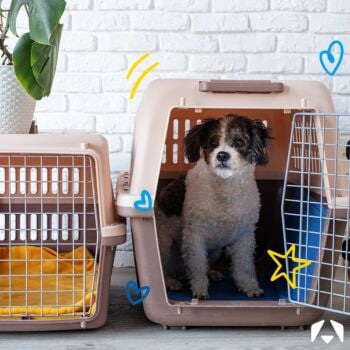Border Terrier
Originally bred to keep the fox population under control, these feisty terriers have incredible stamina and determination. This should be kept in mind, as without correct mental and physical stimulation, Border Terriers can become mischievous – digging and barking unnecessarily.
The most defining feature of a Border Terrier is their ‘Otter-like’ head. They have a coarse, dense top coat and a softer undercoat. The nature of their coat means they are relatively low maintenance, however brushing weekly will help keep loose, fly-away hairs at bay.

Otter Border Terrier Head Comparison
Clipping this coat will result in a dramatic change in texture and colour. The correct harsh wire coat needs to be encouraged by plucking the blown coat when it is ready to be removed. This stimulates hair follicles to produce new guard hair. Without stripping the guard coat will not grow in properly and will lose it’s brilliant colour and texture. If only the undercoat grows it will have a softer, lighter colour.
Coat Type
Hard / Wiry
Grooming Requirement
Hand – Strip
Pet Grooming (Optional)
Clipper Trim
Grooming Notes
If you are planning on clipping the coat it is recommended to use any blade within the range #4F – #7F or short-medium comb guides for the body. The longer to leave the coat, the more you’ll be able to retain the natural look of the coat texture and colour. If clipping the coat, using a coat rake/carding tool after clipping, can help to promote correct coat growth and colour.
- Clipping this coat type will normally destroy the correct harsh texture and brilliant colour. The coat will become soft and colours muted
- Stripping a coat is a technique that takes time and practice to master. You should always work in the direction of growth and a light application of stripping/chalk powder can improve grip on the hair. The hair should release easily, without excessive force. Hand stripping should be rhythmic and therapeutic to both dog and groomer
Grooming Guide
Before Bathing
- Use a blaster to lift away dirt, dander and loose/shedding hair
- Using an undercoat rake, pumice stone, slicker, shedding blade or rubber curry to remove the loose coat, the more coat you remove this way the quicker and easier your hand stripping will be
- Hand strip the body, tail and legs. The harsh coat should be ¼ “ – 1” all over the dog, the coat on the body will be slightly longer than that on the legs and head. The muzzle can have slightly longer hair that stands off the skin. Any change in length of the coat should be gradual, well blended and natural. The cheeks, throat and sanitary areas tend to be more sensitive, so may require thinning scissors or clippers
- The ears might need a few longer hairs plucked away to have a velvet texture. If the ear has a generous covering of hair, you can clip with a #15 blade outside.
- The top of the muzzle can be cleared by plucking or using thinning scissors, depending on the amount of hair and sensitivity of the dog. A small amount of hair can be left above each eye to accentuate it, but not enough to be confused with an eyebrow.
- It is recommended to leave the coat for 24 hours after stripping before bathing to allow the hair follicles to close
After Bathing
- Use a blaster to remove any excess water and loose hair
- Hair can be plucked from the ear canal as necessary to promote healthy ears
- Ears can be clipped very close using a #40 inside. Edge the ears with detailing scissors
- Neaten undercarriage and underneath tail with thinning shears to be neat and tidy
- Trim pads with a #15 – #40 or safety/toe scissors. Neaten feet with detailing/safety scissors and trim hocks with thinning scissors if needed.
Grooming Tool Recommendations
- Nail Trimmers
- Hemostats (Forceps)
- Clippers
- Firm/Medium Slicker
- Pumice / Stripping Stone
- Carding / Stripping Knives
- Greyhound Comb
- De-Shedding Tools
- Thinning Scissors
- Detailing/Safety Scissors
- Blaster
Other Health Recommendations
Clipper Blade Recommendations
- Inside Ears & Paw Pads – #15 – #40
- Outside Ears – #10 or #15
- Body (Pet Trim) – #4F – #7F / Short- Medium Comb Guide
Shampoo Recommendations
For everyday use, mild/hypoallergenic shampoos are recommended. This coat must not be softened to maintain it’s correct texture.
Conditioner Recommendations
This coat type doesn’t require any conditioner on the top coat but you may want to use a texturising/rinse conditioner to help remove shampoo residue and improve texture





